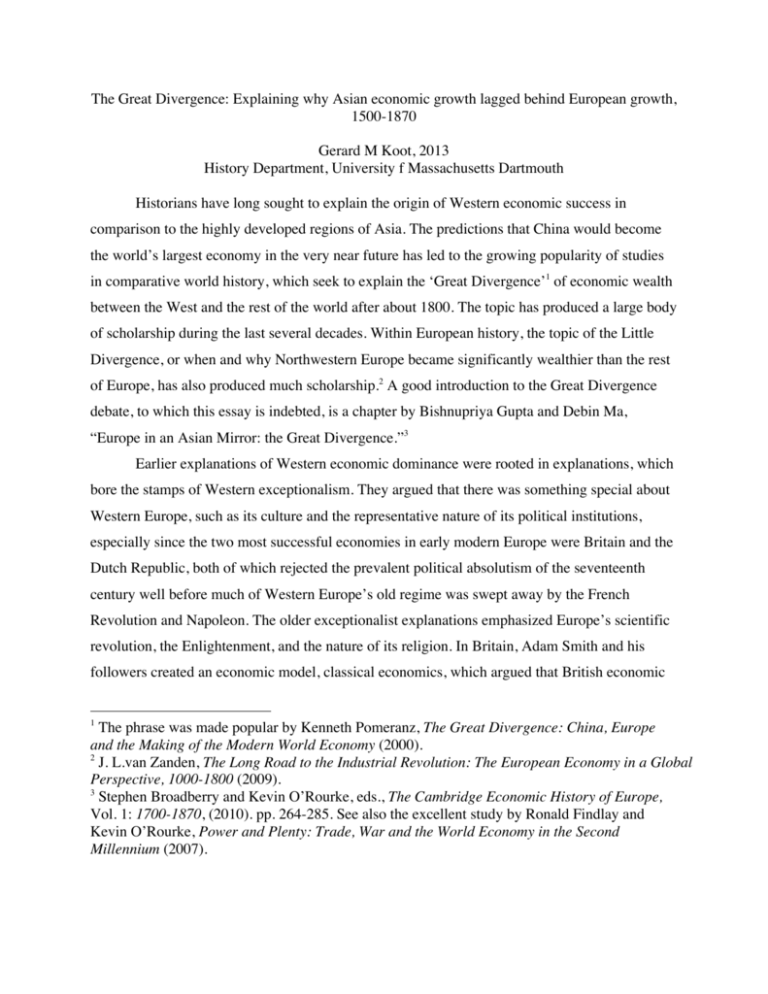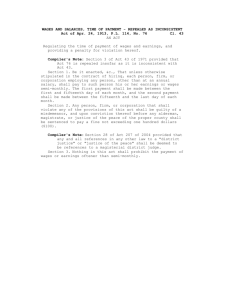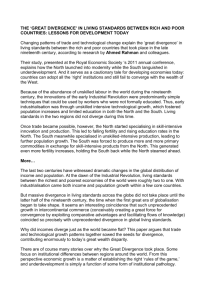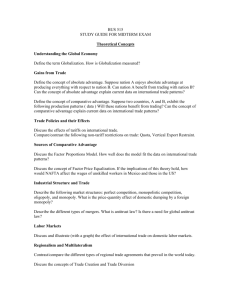The Great Divergence: Explaining why Asian economic growth
advertisement

The Great Divergence: Explaining why Asian economic growth lagged behind European growth, 1500-1870 Gerard M Koot, 2013 History Department, University f Massachusetts Dartmouth Historians have long sought to explain the origin of Western economic success in comparison to the highly developed regions of Asia. The predictions that China would become the world’s largest economy in the very near future has led to the growing popularity of studies in comparative world history, which seek to explain the ‘Great Divergence’1 of economic wealth between the West and the rest of the world after about 1800. The topic has produced a large body of scholarship during the last several decades. Within European history, the topic of the Little Divergence, or when and why Northwestern Europe became significantly wealthier than the rest of Europe, has also produced much scholarship.2 A good introduction to the Great Divergence debate, to which this essay is indebted, is a chapter by Bishnupriya Gupta and Debin Ma, “Europe in an Asian Mirror: the Great Divergence.”3 Earlier explanations of Western economic dominance were rooted in explanations, which bore the stamps of Western exceptionalism. They argued that there was something special about Western Europe, such as its culture and the representative nature of its political institutions, especially since the two most successful economies in early modern Europe were Britain and the Dutch Republic, both of which rejected the prevalent political absolutism of the seventeenth century well before much of Western Europe’s old regime was swept away by the French Revolution and Napoleon. The older exceptionalist explanations emphasized Europe’s scientific revolution, the Enlightenment, and the nature of its religion. In Britain, Adam Smith and his followers created an economic model, classical economics, which argued that British economic 1 The phrase was made popular by Kenneth Pomeranz, The Great Divergence: China, Europe and the Making of the Modern World Economy (2000). 2 J. L.van Zanden, The Long Road to the Industrial Revolution: The European Economy in a Global Perspective, 1000-1800 (2009). 3 Stephen Broadberry and Kevin O’Rourke, eds., The Cambridge Economic History of Europe, Vol. 1: 1700-1870, (2010). pp. 264-285. See also the excellent study by Ronald Findlay and Kevin O’Rourke, Power and Plenty: Trade, War and the World Economy in the Second Millennium (2007). 2 growth was primarily a consequence of the pursuit of economic efficiency through individual initiative, the division of labor and free trade. Others, such as the historical economists in Germany and elsewhere, argued that during the 19th century Britain’s economic success was greatly helped by its vigorous pursuit of mercantilist and imperialist policies by which the state used protectionist measures and military power to support its merchants and industrialists. Already in the mid-19th century. Karl Marx, and other socialists had begun to argue that the chief source of the West’s economic success was to be found in capitalism’s inherent exploitation, which, according to its Leninist version, led to the inevitable capitalist exploitation of the peoples and resources of the less developed world. According to Marxist historians, it was Imperialism, accompanied by Western racism, which had made the West economically successful in a vain effort to postpone the inevitable collapse f capitalism. During the second half of the twentieth century, economic historians began to use sophisticated economic theory and a growing body of historical statistical evidence to try to explain the origin and maintenance of Western economic success. In Western societies the orthodox explanation of the origin of the West’s economic success relies upon neoclassical economic theory and statistical data and argues that the Great Divergence between northwestern Europe and Asia can be seen already in the 16th century and is rooted in the regions’ higher standard of living, which encouraged technical innovation, and favorable institutions for economic growth. A contrary and revisionist position has been articulated by an important group of Asian historians, such as Kenneth Pomeranz, Bin Wong, Prasannan Parthasarati and others.4 They provided evidence that demonstrates that the standard of living in advanced parts of India and China was about the same as in eighteenth century northwestern Europe. They have also offered other arguments in terms of resource endowments, the impact of Western imperialism, and historical path dependency in order to argue that the traditional “rise of the West” explanation is wrong. Path dependency is a social science concept that argues that a society’s future choices are limited by choices made in the past, even though the circumstances in which these choices were made are no longer relevant. 4 Pomeranz, The Great Divergence (2000): R. Bin Wong, China Transformed: Historical Change and the Limits of European Experience (1997); and Prasannan Parthasarati, Why Europe Grew Rich and Asia did not: Global Economic Divergence, 1600-1850 (2011). 3 The conclusion of the Asian revisionist historians that the most developed parts of China and India had a similar standard of living than northwestern Europe has been challenged by recent research that argues that a divergence of living standards can be observed as early as the 16th century, which was well before European colonization and an extensive European trade with Asia. This conclusion is based upon a number of studies, summarized in the tables below, which compare wages in Europe and developed parts of Asia in comparable terms expressed in the wages of skilled and unskilled workers expressed in grams of silver and the amount of grain these wages could purchase. Northern and Western India silver and grain wages, 1595-1874 Southern India silver and grain wages, 1595-1874 Source: Gupta and Ma, p. 267. 4 The tables below compare Indian wages with those in England. It shows that the Indian silver wage for unskilled labor was little more than one-fifth of that in England and fell to one-seventh of the wage in England during the 18th century. Comparison of the daily wages in silver of English and Indian unskilled workers, 1550-1849 Comparison of the daily wages in grain of English and Indian unskilled workers, 1550-1849 Source: Gupta and Ma, p. 268 The table above shows that the Indian grain wages for unskilled workers remained relatively high, at above 80% of the English level during the second half of the 17th century, but then declined to only about a third of the English level by the late 18th century. 5 Comparison of the daily wages in silver of English and Chinese unskilled workers, 1550-1849 Comparison of the daily wages in grain of English and Chinese unskilled workers, 1550-1849 Source: Gupta and Ma, p. 269 The tables above are all based on S. N. Broadberry and B. Gupta “The Early Modern Great Divergence: Wages, Prices and Economic Development in Europe and Asia, Economic History Review 59 (2006): 2-31. The tables above show that, in contrast to the rising trend in silver wages, grain wages trended downwards in northern and western India as money wages failed to keep up with rising grain prices. While grain wages were always above subsistence for skilled workers, they fell below subsistence level for unskilled workers during the 18th century. Broadberry and Gupta conclude: “the silver wage data suggests unambiguously, then, that the Great Divergence was already well established in the sixteenth century.”5 While Asian grain wages remained close to the English level to the late 17th century, the data demonstrates a sharp divergence during the 18th century. As a result, the wage levels of China and India look more like those of the less developed parts of Europe from the sixteenth century. Economists argue that high money wages over a long period of time are a sign of a high stage of economic 5 Gupta and Ma, p. 268. 6 development, while high grain wages reflect an abundance of grain. Low silver wages are associated with a lower level of economic development. In the most developed parts of Western Europe during the early modern period there was a good deal of investment in agriculture that raised agricultural productivity. This did not, however, result in an abundance of grain and low food prices, because workers moved out of agriculture into services and industry. The rising living standards of highly developed areas of Western Europe were a consequence of a greater consumption of cheaper industrial goods and a relatively constant consumption of food. While rice production in parts of China and East Asia created one of the highest levels of land productivity in the world using traditional technology, labor productivity was relatively low compared with the highly commercialized agriculture of English and Dutch agriculture during the early modern period.6 Using wage data based on grain for establishing the standard of living is of course a very simplistic model. While the consumption of grain was fundamental to subsistence, even unskilled workers consumed other foods and bought other products. Recent studies using more complex baskets of consumption have, however, confirmed the general argument that the standard of living, and thus the cost of labor, was already significantly higher in the most developed parts of Europe than the most developed areas of Asia during the 17th century. Robert Allen, et al., studied the history of wages and prices in Beijing, Canton, and Suzhou/Shanghai from the eighteenth century to the twentieth, and compared them with leading cities in Europe, Japan, and India in terms of nominal wages, the cost of living, and the standard of living. They concluded: “In the eighteenth century, the real income of building workers in Asia was similar to that of workers in the backward parts of Europe but far behind that in the leading economies in north-western Europe. Real wages stagnated in China in the eighteenth and early nineteenth centuries and rose slowly in the late nineteenth and early twentieth, with little cumulative change for 200 years. The income disparities of the early twentieth century were due to long-run 6 Gupta and Ma, p. 270. 7 stagnation in China combined with industrialization in Japan and Europe.”7 Their conclusion can be seen graphically in the graph below. One of the interesting conclusions of the standard of Real Wages in Europe and China, 1738-1918. Source, Allen et. al., (2011). living studies demonstrate that the standard of living of in the major cities of China in the mid 18th century was similar to that of less developed European cities but by the twentieth century the standard of living in all parts of Europe was higher. A surprising conclusion is that the gap in living standards between unskilled and skilled workers in both northwestern European cities and Chinese cities widened after the middle of the 19th century. A final conclusion that can be drawn from these studies is that the thesis of the ‘Rise of the West’ literature, which sees Western Europe as a whole surpassing the rest of the world during the early modern period should be questioned. Recent research “suggests that it was only England and the Low Countries that pulled ahead of the rest. The rest, in this context, includes not only Asia but also much of Europe.”8 7 Robert C. Allen, Jean-Pascal Bassino, Debin Ma, Christine Moll-Murata And Jan Luiten Van Zanden,” Economic History Review 64, S1 (2011): 27. 8 Allen, et. al., (2001): 31. 8 There are other ways to measure historical standards of living, such as anthropometric measures, especially height. These are widely used in European economic history but there appears to be much less accessible data on this for Asia. From the data and studies available, it appears that human height stagnated in 19th century China while it increased in Europe, especially in northwestern Europe. Literacy rates are another measure used to assess living standards. Available studies for Asia suggest that literacy was confined to the upper castes in India and the general rates were extremely low until the late 20th century. Literacy rates for China and Japan appear to have been significantly higher than in India. The level of urbanization is yet another indication of living standards. In 1600 there were thirty-two urban centers in the Mughal Empire, which manufactured cotton textiles and other handicraft products. India, however, remained overwhelmingly agricultural. Its urban population in 1600 has been estimated at 15% and declined in the 18th and 19th centuries. Urbanization rates in cities over 10,000 in 1800 were 3 to 4% in China, 6% in India, 12% in Japan and the Middle East, 8 to 9% in Europe as a whole, 22.3% in England, and 28.6% in the Netherlands. It has been argued that the data is somewhat problematic for China since its most urban area, the lower Yangtze, was a very densely populated manufacturing area for cotton textiles, food processing, apparel, tobacco, papermaking, printing, tool-making, and shipbuilding. Yet, no large cities developed in the region between 1550 and 1850. Instead, it was an area of clusters of specialized towns strung out along the river system along with a highly developed agriculture. Nonetheless, urbanization rates in China were lower than in Europe and much lower than in England and the Netherlands during the early modern period.9 Gupta and Ma believe that institutions and historical path-dependencies are crucial components of the Great Divergence between Asia and Europe. However, the scholarship on Asian institutions has been relatively neglected in the study of the Great Divergence. One promising approach has been the study of Asian market efficiencies by looking at prices in interregional Asian trade. The assumption behind this is that developed economies have a high level of market integration so that prices of widely traded commodities should be similar in a 9 Paolo Malanima, “Urbanization,”Stephen Broadberry and Kevin O’Rourke, eds., The Cambridge Economic History of Europe, Vol. 1: 1700-1870, Cambridge: 2010). pp. 235-263. 9 developed region. Studies of grain prices, for example, show that the grain market integration in China was similar to that of European averages in the late 18th century, but that market integration was higher in England than in the highly developed Yangtze delta in China. Studies have also found that grain market integration in India was significantly lower. The economic history of China and India demonstrate that both areas had well developed commercial long distance trading networks in specialized manufactured goods and food products before and during the arrival of European traders in Asian waters. Indian merchant ships carried goods to Alexandria, Basra, and Baghdad. They sailed east to Sumatra and Southeast Asia but not to the China seas, where the Chinese dominated. Commodities traded included primary goods, such as rice, pulses, sugar, spices and raw silk. Textiles were the most important manufacturing goods traded. Both China and India imported a good deal of gold and silver, as well as horses from west Asia and ivory from Africa. Economic historians argue that the Asian trade system was comparable to the interregional European trade system. These trading systems had their own systems of insurance, banking, credit and money, which included the discounting of bills of exchange and deposit banking. Developed economies require that merchants, traders and manufacturers adhere to complex and enforceable rules. It has long been argued that the legal institutions of the West had an advantage over the more informal economic institutions prevalent in Asia. Recent research, however, suggests that pre-modern China had a much more formal system of civil and commercial law than was once believed. Some historians have also argued that the rules and commercial customs of private groups, as opposed to public and state law, were much more efficient in regulating trade in Asia and North Africa than has been previously argued. Nonetheless, these group rules, while successful enough for the level of trade in the early modern period, created path dependencies that postponed the adoption of more formal and state enforced legal contracts characteristic of a higher stage of economic development in Asia and North Africa. Gupta and Ma note that one of the consequences of the development of group regulated economic institutions in Asia resulted in higher interest rates in Asia than in Europe, especially in northwestern Europe. Interest rates in Surat, India, were in the order of 7.5 to 9% in the mid 17th century, which was at least twice as high as in England and Holland. Another recent study 10 suggests that interest rates in China for commercial rates averaged at least 12% in China from the 17th to 19th centuries. The large difference in the cost of borrowing money between northwestern Europe and Asia may have played an important role in the Great Divergence during the early modern period.10 The crucial question about the Great Divergence thesis is: Did Western imperialism lead to the divergence of economic growth and welfare between the East and the West? In the case of India, which was ruled by the East India Company and then by the British state from the late 18th century to 1947, there is no doubt that Britain had a considerable impact upon India. There was some transfer of colonial resources to Britain, the introduction of a new land tenure system based on individual property rights, the connection of India to the superior capital market of Britain, its linkage to a global economy for specialized products, and the building of an Indian railway network and irrigation systems. The dependency school of historians see the imperial connection of India and Britain as exploitative and argued that the development of a specialized EuropeanIndian trade caused a growing gap between European and Indian standards of living.11 One of the classic arguments for the adverse impact of British rule upon India was that the efficiency of Britain’s textile manufacturing severely curtailed India’s traditional textile industry and its exports, which had been a mainstay of India’s Asian trade system12. Others, however, argue that linking India to global markets promoted India’s economic development.13 The empirical evidence is that Indian economic growth was less than growth in Europe during the latter part of the colonial period. At the same time, studies suggest that the economic benefit to Britain of imperial rule in India was low.14 Gupta and Ma conclude: “While colonial rule may have widened he gap between East and West, other evidence…suggests that the roots of economic divergence go back to the seventeenth century.”15 10 Gupta and Ma, pp. 267-282. A. G. Frank, On Capitalist Underdevelopment (1975). 12 D. Thorner and A. Thorner, Land and Labor in India (1962). 13 T. Roy, The Economic History of India 1857-1947, 2nd edn. (2006). 14 P. K. O’Brien, “The Costs and benefits of British Imperialism, 1846-1914,” Past and Present, 120 (1988): 163-200; L. E. Davis, Mammon and the Pursuit of Empire (1988). 15 Gupta and Ma, p. 283. 11 11 In contrast to India, Western imperialism had little impact upon Asia until the 1840s when British gun boats opened up China to free trade as a result of the Opium Wars. Western imperialism never subjected China to foreign rule, as was the case in India and many other areas of Asia. Instead, it limited itself to treaty ports and special trading rights in coastal regions. At the same time, it brought foreign investment and new technology to China. Perhaps the West’s greatest impact on China was in helping to bring about the political collapse of the Qing dynasty in 1911, which had been a fairly successful ruler of China in the 18th and early 19th centuries. Nonetheless, Shanghai and other treaty ports that adopted many Western institutions, saw considerable economic growth during the first three decades of the 20th century. Moreover, Meiji Japan, which aggressively adopted many Western institutions and welcomed Western technology after 1872, became Asia’s first and most successful modern industrial economy. Thus, it is possible to argue, that Western institutions provided an important intellectual stimulus to Asian economic development. In any case, it appears that “the advanced parts of Asia—India and China—looked more similar to the backward parts of Europe than to the advanced northwest during the early modern period. The Great Divergence was well underway in the seventeenth century”16 at a time when the influence of the West was still very modest in Asia. 16 Gupta and Ma, p. 285.






